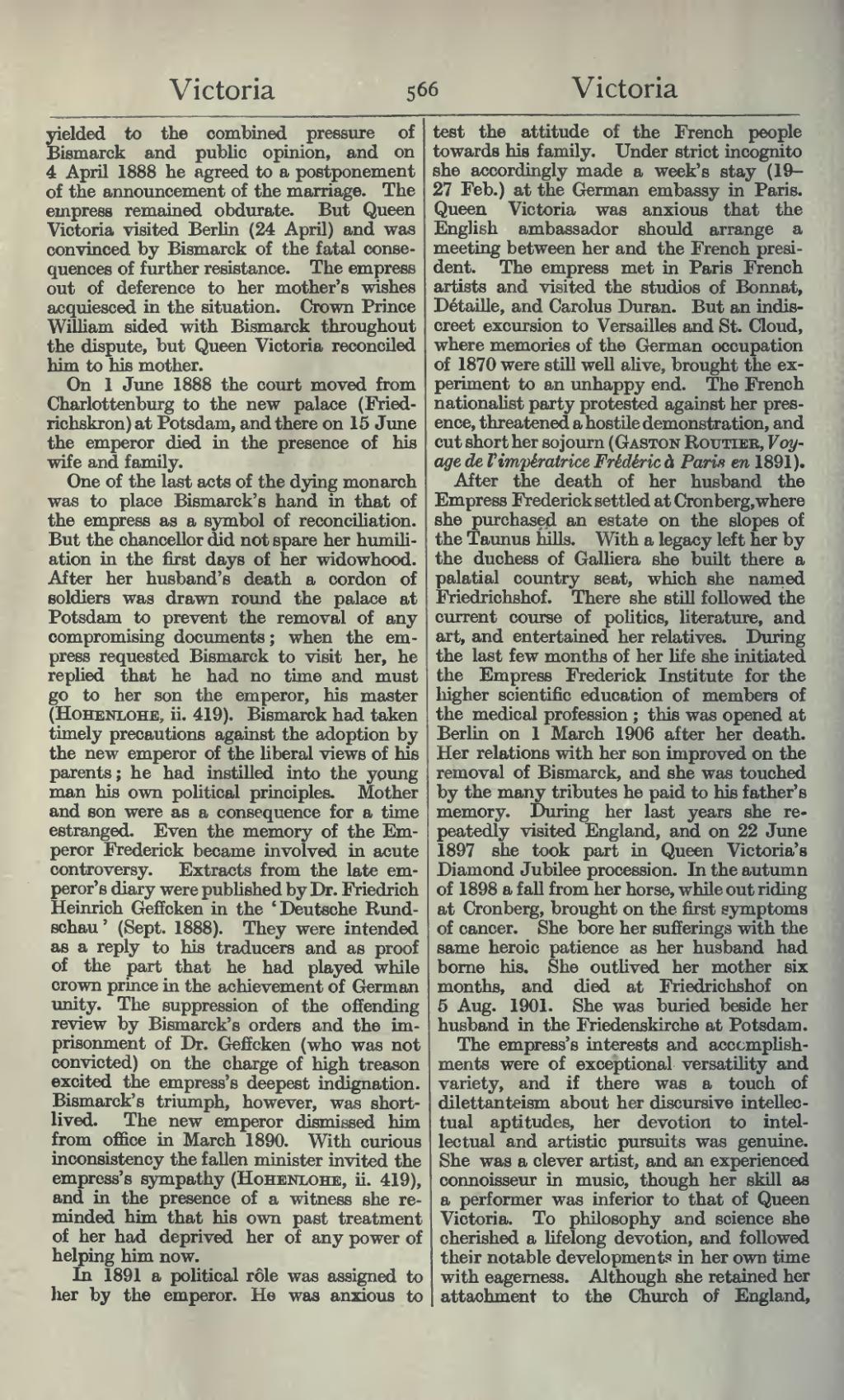yielded to the combined pressure of Bismarck and public opinion, and on 4 April 1888 he agreed to a postponement of the announcement of the marriage. The empress remained obdurate. But Queen Victoria visited Berlin (24 April) and was convinced by Bismarck of the fatal consequences of further resistance. The empress out of deference to her mother's wishes acquiesced in the situation. Crown Prince William sided with Bismarck throughout the dispute, but Queen Victoria reconciled him to his mother.
On 1 June 1888 the court moved from Charlottenburg to the new palace (Friedrichskron) at Potsdam, and there on 15 June the emperor died in the presence of his wife and family.
One of the last acts of the dying monarch was to place Bismarck's hand in that of the empress as a symbol of reconciliation. But the chancellor did not spare her humiliation in the first days of her widowhood. After her husband's death a cordon of soldiers was drawn round the palace at Potsdam to prevent the removal of any compromising documents ; when the empress requested Bismarck to visit her, he replied that he had no time and must go to her son the emperor, his master (Hohenlohe, ii. 419). Bismarck had taken timely precautions against the adoption by the new emperor of the liberal views of his parents; he had instilled into the young man his own political principles. Mother and son were as a consequence for a time estranged. Even the memory of the Emperor Frederick became involved in acute controversy. Extracts from the late emperor's diary were published by Dr. Friedrich Heinrich Geffcken in the 'Deutsche Rundschau' (Sept. 1888). They were intended as a reply to his traducers and as proof of the part that he had played while crown prince in the achievement of German unity. The suppression of the offending review by Bismarck's orders and the imprisonment of Dr. Geficken (who was not convicted) on the charge of high treason excited the empress's deepest indignation. Bismarck's triumph, however, was short-lived. The new emperor dismissed him from office in March 1890. With curious inconsistency the fallen minister invited the empress's sympathy (Hohenlohe, ii. 419), and in the presence of a witness she reminded him that his own past treatment of her had deprived her of any power of helping him now.
In 1891 a political role was assigned to her by the emperor. He was anxious to test the attitude of the French people towards his family. Under strict incognito she accordingly made a week's stay (19-27 Feb.) at the German embassy in Paris. Queen Victoria was anxious that the English ambassador should arrange a meeting between her and the French president. The empress met in Paris French artists and visited the studios of Bonnat, Détaille, and Carolus Duran. But an indiscreet excursion to Versailles and St. Cloud, where memories of the German occupation of 1870 were still well alive, brought the experiment to an unhappy end. The French nationalist party protested against her presence, threatened a hostile demonstration, and cut short her sojourn (Gaston Routier, Voyage de l’impiratrice Frédéric à Paris en 1891).
After the death of her husband the Empress Frederick settled at Cronberg, where she purchased an estate on the slopes of the Taimus hills. With a legacy left her by the duchess of Galliera she built there a palatial country seat, which she named Friedrichshof . There she still followed the Current course of politics, literature, and art, and entertained her relatives. During the last few months of her life she initiated the Empress Frederick Institute for the higher scientific education of members of the medical profession ; this was opened at Berlin on 1 March 1906 after her death. Her relations with her son improved on the removal of Bismarck, and she was touched by the many tributes he paid to his father's memory. During her last years she repeatedly visited England, and on 22 June 1897 she took part in Queen Victoria's Diamond Jubilee procession. In the autumn of 1898 a fall from her horse, while out riding at Cronberg, brought on the first symptoms of cancer. She bore her sufferings with the same heroic patience as her husband had borne his. She outlived her mother six months, and died at Friedrickshof on 5 Aug. 1901. She was buried beside her husband in the Friedenskirche at Potsdam. The empress's interests and acccmplishments were of exceptional versatility and variety, and if there was a touch of dilettanteism about her discursive intellectual aptitudes, her devotion to intellectual and artistic pursuits was genuine. She was a clever artist, and an experienced connoisseur in music, though her skill as a performer was inferior to that of Queen Victoria. To philosophy and science she cherished a lifelong devotion, and followed their notable developments in her own time with eagerness. Although she retained her attachment to the Church of England,
